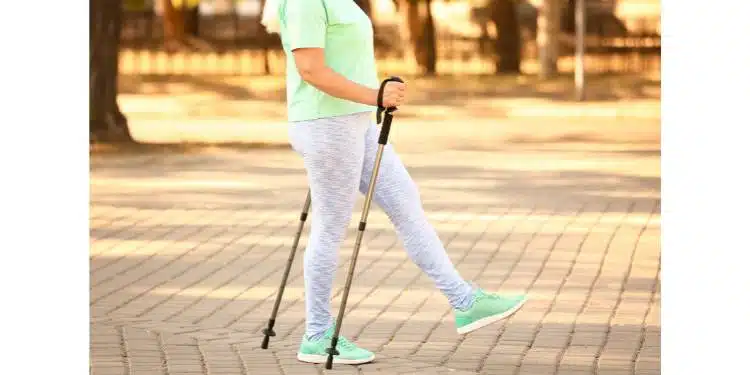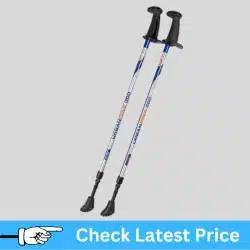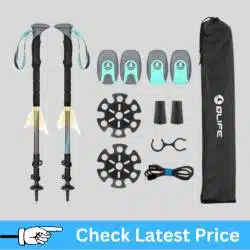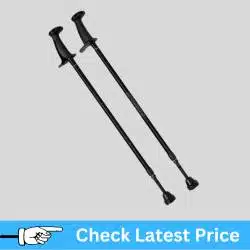Discover these game-changers for older adults who love to walk outside: walking and trekking poles! When I was younger, I thought walking poles were just for the elderly. Now I see them used all over by both avid hikers and those simply out for a stroll. These poles have become the go-to companions for older adults of all ages and abilities. Many seniors, including me, enjoy using them to optimize their walking or hiking experiences.
Imagine having your own support system as you explore the outdoors. Feel safe and confident using walking or trekking poles, even on uneven terrain. Whether it’s a casual neighborhood walk or a nature hike, these poles adapt to your pace. They can also help prevent future damage and injuries to your lower back and knees and burn more calories. In other words, they can bring joy back to outdoor activities.
We know exercise is essential for older adults. Simply put, we need to keep moving. Walking is an inexpensive exercise most of us can do, and a wonderful way to enhance your physical health, boost your mood, and foster social connections.

Understanding Walking and Trekking Poles
Walking poles, also known as trekking poles, hiking poles, or walking sticks, are accessories designed to provide stability and support for various activities like walking, hiking, and backpacking. Outdoor enthusiasts of all ages widely use them to enhance their hiking experience and promote safety and comfort during outdoor activities.
What are Walking Poles?
Walking poles come in different designs and may include features such as shock absorption, ergonomic grips, and interchangeable tips for different trail conditions. They often come with adjustable height settings to accommodate individual preferences. Both types of poles, typically used in pairs, help distribute weight, reduce impact on joints, and engage upper body muscles, contributing to a more secure and enjoyable outdoor experience.
The use of walking poles in outdoor activities among older adults has a rich history that dates back to the early tradition of walking sticks and canes. While these tools have been used for centuries for support and stability, modern walking poles are also valued for enhancing balance and mobility. In recent decades, researchers and health experts highlighted the perks of walking poles for seniors, including the reduced risk of falls, improved posture, and added stability during outdoor walks. The fitness and wellness community followed, embracing walking poles as an easygoing exercise option, promoting cardiovascular health and muscle engagement. Today, walking poles are commonly recommended for seniors as a practical aid for outdoor activities, contributing to an active and healthy lifestyle in later years.
How to Choose the Best Walking Canes and Sticks for Seniors
Why Walking and Trekking Poles are Beneficial for Seniors
Walking and trekking poles are fantastic companions, playing a crucial role in promoting healthy routines by offering valuable support and stability during outdoor activities. These poles distribute weight, ease the impact on joints, and engage upper body muscles, contributing to improved posture, balance, and overall physical well-being. They provide a low-impact form of exercise that enhances cardiovascular health while enhancing muscle strength and coordination. Beyond the physical benefits, walking poles contribute to an active and social lifestyle, encouraging the exploration of outdoor environments with confidence. By incorporating walking poles into our routines, we can enjoy improved mobility, reduced joint strain, and a more enjoyable outdoor experience, contributing to a holistic and healthy lifestyle as we age. Prioritizing activities that promote balance, stability, and joint health allows us to enjoy a higher quality of life, maintain independence, and engage in activities we love for longer.
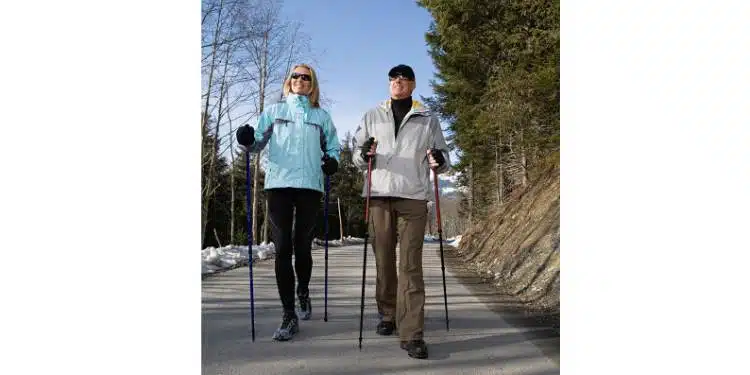
Benefits of Using Walking Poles for Seniors
The specific benefits of using walking poles for seniors are many. Older adults love their practical benefits in terms of joint support, balance, posture, and how they contribute to their overall enjoyment of outdoor activities.
Improved Balance and Stability
Walking poles offer a multi-faceted approach to improved balance and stability. They distribute your body weight evenly as you stroll, taking the load off your lower limbs and giving your stability a serious boost. Plus, when you plant your poles, widening your base of support, your upper body muscles – especially the arms and shoulders – get in on the action, adding a dash of coordination to your walk. The engagement of the upper body also promotes a more upright posture, which is crucial for maintaining balance.
Joint Health and Reduced Impact
Increased Cardiovascular Health
Walking with poles isn’t just a casual stroll – because you are upgrading your walk to a full-body workout, there are added benefits for increased cardiovascular health. These poles transform an ordinary walk into a power-packed activity that engages your arms and shoulders along with your legs. The rhythmic use of walking poles elevates your heart rate, promoting better endurance and a more intense workout. With deeper breathing and increased oxygen consumption, your heart becomes a happier, more efficient pump. It’s like giving your cardiovascular system an extra boost while enjoying the great outdoors. At the same time, walking poles promote a 20% increase in calorie burn compared with regular walking because of the addition of your upper body muscles to the workout.
Enhanced Walking Efficiency and Endurance
When I first started to use walking poles, I felt like I found the secret to longer walks with less wear and tear. Others tell me they felt the same way. With poles, you can likely walk longer without feeling fatigued. Each step is more efficient because the walking poles redistribute the workload, engaging your upper body along with your legs. You may also feel, as I do, that you can walk faster without feeling like you’re exerting extra effort because with walking poles you naturally fall into a more rhythmic and efficient walking pattern. Not only that, but the stability provided by the poles helps maintain a consistent speed and you can therefore cover more ground with each stride.
Maintaining good posture and technique while using walking poles is key to maximizing their benefits and preventing discomfort or strain. Here are a few tips to keep in mind:
- Start with the Right Length: Ensure your walking poles are adjusted to the correct length. When holding the grips, your elbows should be at a comfortable angle of about 90 degrees.
- Grip and Wrist Position: Hold the poles with a relaxed grip, allowing your wrists to stay straight. Avoid holding the poles too tightly, as this can lead to hand and wrist fatigue.
- Plant the Poles Correctly: Plant the poles slightly behind you, angled backward. As you step forward, the poles should provide support and push you along, similar to the natural arm swing that occurs during walking.
- Maintain Upright Posture: Keep an upright posture while walking with poles. Avoid leaning too far forward or backward. Engage your core muscles to support your spine.
- Coordinate Arm and Leg Movement: Coordinate the movement of your arms and legs. As one leg moves forward, the opposite arm should swing forward with the pole. This natural coordination enhances balance and stability.
- Adjust for Uphill and Downhill: When walking uphill, shorten the poles to help propel yourself upward. Conversely, on downhill slopes, lengthen the poles to provide stability and reduce impact on your knees.
- Practice a Natural Arm Swing: Let your arms swing naturally with the poles, mimicking the arm swing you would have during regular walking. This helps distribute the workload evenly.
Mental Health and Social Benefits
Walking isn’t just a physical exercise; it’s a powerhouse for mental health and social well-being. For example, regular walks work wonders for reducing stress and anxiety. The rhythmic motion and fresh air create a peaceful, calming experience. For me, it’s like a mini escape from the daily hustle and bustle of life, providing a chance to reset and recharge. Then there’s the social side of walking. Joining a walking group or simply strolling with friends turns exercise into a social affair. It’s not just about the physical benefits; it’s about the joy of shared moments. I find conversation and laughter help build connections that go far beyond the pavement. Walking together creates a sense of community, where everyone is moving towards better health and happiness. Each step strengthens not just your body but your social bonds too.

Types of Walking and Trekking Poles Available
Fixed Length Poles
Fixed-length poles are walking or trekking poles that have a predetermined, non-adjustable length. Known for their simplicity and durability, they are great for those who want a straightforward, no-fuss set-up. No adjusting is required, just pick your size and let the adventure begin! These poles typically come in various lengths, and users choose the ones that best suit their height and preferences. They are generally lighter than their adjustable counterparts because they don’t have additional components like locking mechanisms. Keep in mind that while fixed-length poles provide ease of use and reliability, they do not offer the versatility that adjustable poles provide, especially in varying terrains or when different users share the poles.
Adjustable Poles
Most professionals recommend adjustable walking poles over fixed-length poles. As they come with telescopic shafts for customizable lengths, they offer unparalleled adaptability for users. Adjustable poles work well for people of different heights, so friends or family members can easily share one set if desired. I especially like the versatility of adjusting pole length poles to enhance stability and support in different areas. For example, you can shorten them for uphill climbs or lengthen them for downhill descents.
Adjustable poles have a telescopic design that allows them to collapse for easy storage and transportation. Efficient quick-lock mechanisms or twist locks add practicality for swift switches between using and stowing the poles. Additionally, adjustable poles generally have shock-absorbing features, such as internal springs or damping systems which help minimize joint impact and fatigue on extended walks. All in all, these adjustable poles ensure a personalized and comfortable walking experience for everyone involved.
How to Adjust Walking Poles Correctly:
Adjusting the walking poles correctly is important to maximize their benefits. Here are some tips to help you ensure they meet your needs.
Unlock the Mechanism: Depending on the type of adjustable mechanism (twist lock, lever lock, or clamp lock), unlock the poles by twisting, flipping open the lever, or releasing the clamp.
Adjust the Length: Slide the sections of the pole to the desired length. Many poles have markings indicating height measurements, making it easier to match both poles to the same length.
Secure the Lock: Once you adjust the length, securely lock the mechanism in place. For twist locks, twist until tight; for lever locks, close the lever, ensuring a firm grip; for clamp locks, tighten the clamp until secure.
Check Stability: Give the poles a gentle shake and ensure they are securely locked in position. A stable and secure lock is crucial for the effectiveness and safety of the poles.
Repeat for the Second Pole: Adjust the second pole to the same length as the first, following the same steps. Symmetrical pole lengths contribute to balanced and comfortable walking.
Below are some adjustable walking poles I like that are sold on Amazon.
Lightweight Adjustable Nordic All-Season Walking Poles
Folding Poles
Love to walk or hike on vacation? Folding poles are a practical solution for travel and storage headaches. Their collapsible nature means they’re ready to be packed efficiently, slipping into your luggage or backpack without fuss. No need for extra storage arrangements—just fold and stash. When you’re on the move, they unfold with a straightforward efficiency, whether you’re navigating urban streets or nature trails. And when the adventure is over, these poles don’t demand much real estate in your closet, making them the no-nonsense choice for those who value simplicity and space-saving functionality.
Ultralight Folding Walking Poles, Lightweight Aluminum 
Trek-Z Ergonomic Trekking Poles (set of 2) give you a reason to increase the steps you take. Engineered and built to last, these lightweight poles are meant to withstand pressure and impact and provide you with a comfortable experience. The compact design is ready to go when you are as they fold down to a portable 15 inches, thanks to its retractable tri-fold system. In addition, you can adjust the length of the poles quickly and easily using an innovative metal flip lock technology. Each package of walking poles comes in a pair with a holder bag.
Lightweight, Adjustable, and Collapsible Walking Poles – Two Pieces with Flip Locks and Detachable Feet
Sass up your walk with walking poles that come in 16 colorful designs! Who needs boring poles? Adjustable and collapsible, these high-quality walking/hiking/trekking poles adjust easily using a new exclusive flip lock. The set includes 2 hiking poles, detachable rubber feet, and snow baskets, all of which fit in a foldable free black nylon travel bag. Ultra lightweight, these poles are easy to stash in your luggage or backpack.
Poles Designed for Specific Health Conditions or Terrains
Certain walking poles cater to specific health conditions and terrains. Nordic walking poles, with their ergonomic grips and straps, target fitness walking, engaging upper body muscles and enhancing cardiovascular fitness. Trekking poles, ideal for hikers, provide stability on uneven terrain and reduce impact on joints. Mobility aid walking poles serve as supportive tools for individuals with mobility challenges, featuring a broader base and additional stability features. Anti-shock or shock-absorbing poles incorporate mechanisms to minimize impact on joints, benefiting those with joint issues. Urban walking poles, suitable for city environments, may have rubber tips for better traction on pavement. Rehabilitation poles offer adjustability to accommodate users at different stages of recovery. Snowshoeing poles, equipped with larger baskets, provide stability in snowy conditions. When choosing walking poles, considering specific needs and consulting with professionals can ensure the selection of poles tailored to individual requirements and preferences.
Ultralight Trekking Poles with LED Lights
For the avid hiker, here are some trekking poles with rechargeable lights that work well on multiple terrains! These sturdy ultralight poles with foam grips and soft, adjustable wrist straps provide all-day comfort. The lights are more useful than you might think on these extremely functional poles, especially in dimly lit situations or at night. The set includes two mud baskets, two snow baskets, and two rubber tips which can be placed over the built-in carbide tips.
Urban Poles for Balance and Rehab/Stability Walking Poles
Choosing the right walking poles for your specific needs is important. If possible, try different poles before making a purchase. Check for comfort, ease of use, and how well they suit your walking style. Tailoring your choice of walking poles to your individual health conditions and walking habits is crucial for optimizing support, and overall effectiveness.
Factors to Consider
Selecting the right walking poles involves considering several key factors. Three that are especially important are the weight, grip, material, and tip type.
Weight
Consider the weight of the walking poles, as it can impact your comfort during extended use. Lighter poles are generally preferred for reduced fatigue.
Grip
Evaluate the grip design for comfort and functionality. Ergonomic grips with padding or cork provide a comfortable hold, and some grips come with adjustable straps for added support.
Tip Type
The type of tips on the poles influences their performance on different surfaces. Rubber tips provide traction on hard surfaces, while carbide tips offer durability and grip on rough terrain. Some poles have interchangeable tips for versatility.
Tips for Getting Started
So, are walking poles for you? If your goal is to enhance your overall fitness, improve your cardiovascular health, and/or engage more muscle groups during walks, walking poles may be very helpful! If you are not currently a walker, especially if you have concerns about balance, falling, or your joint health, getting started is usually the hardest part. Here are some tips to help you begin:
Learning the Basics
Using walking poles efficiently involves mastering some basic techniques:
- Hold the pole grips with a relaxed but firm grip, utilizing the wrist straps for support.
- As you walk, plant the poles slightly behind and to the side of your feet, angled backward for propulsion and stability.
- Coordinate the movement with your opposite leg, ensuring a balanced rhythm.
- Maintain a slight bend in your elbows, around 90 degrees, and focus on pushing the poles down and back rather than stabbing them into the ground.
- Adjust the pole length based on the terrain, with shorter poles for uphill climbs and longer poles for downhill descents.
- Engage your core muscles to stabilize your torso, which contributes to better posture.
Practice on flat terrain initially to become accustomed to the motion before progressing to more challenging surfaces. As you refine your technique, you’ll experience increased stability, improved endurance, and enhanced upper-body muscle engagement during your walks.
Safety Tips
Using walking poles for the first time can be an enjoyable experience if you prioritize safety. Start by choosing the right poles for your height and the intended terrain. Adjust the pole length according to the activity—shorter for uphill climbs and longer for downhill descents. Familiarize yourself with the basic techniques, such as using the proper grip and where you position the poles during each step of your walk (i.e. when you take a step forward with your right foot, you would plant the left walking pole slightly behind and to the side of your left foot. Similarly, when your left foot moves forward, the right pole is planted behind and to the side of your right foot). The poles should be angled backward, not directly in front of you. This technique allows for better stability, balance, and propulsion as you walk, distributing the workload between your legs and upper body.
Professionals recommend you begin on flat, even terrain to get used to the motion before progressing to more challenging surfaces. It’s important to stay aware of your surroundings at all times, looking for obstacles and changes in terrain. It’s a good idea to practice falling techniques on a soft surface to minimize the impact if a stumble occurs. Regularly check the condition of your poles, and don’t hesitate to seek guidance from experienced users or professionals to ensure a safer experience!
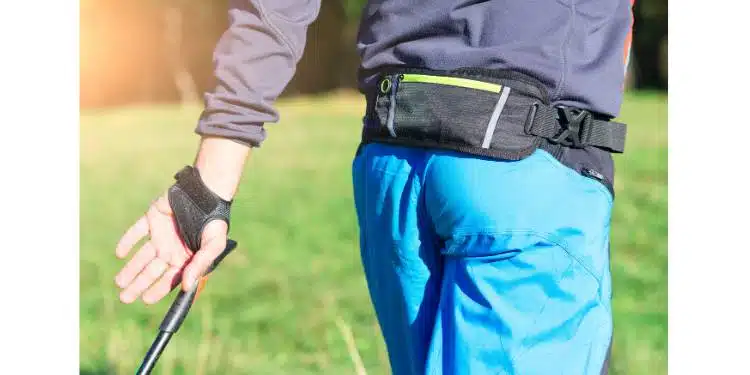
Building a Routine
Incorporating walking poles into your daily or weekly routine can add variety to your exercise regimen while providing numerous health benefits. Here are some tips to seamlessly integrate walking poles into your schedule:
Start Gradually:
If you’re new to walking poles, begin with shorter walks and gradually increase the duration as you become more comfortable with the poles.
Establish a Schedule:
Set a consistent time for your walking pole sessions, whether it’s during mornings, evenings, or weekends. Creating a routine makes it easier to stick with the activity.
Mix Up Your Routes:
Explore different walking paths or trails to keep things interesting. Changing your route not only adds variety but also challenges your body in different ways.
Combine with Other Activities:
Integrate walking poles into other activities, such as hiking, Nordic walking, or even a casual stroll through your neighborhood. This diversifies your routine and provides a full-body workout.
Join Walking Groups:
Consider joining a walking group or club in your community. Walking with others can be motivating, and you may pick up new tips and techniques.
Set Goals:
Establish achievable goals for your walking pole sessions, whether it’s increasing the distance, improving your pace, or exploring new trails. Goals provide direction and motivation.
Make it Social:
Invite friends or family members to join you. Walking with others not only makes it a social activity but also encourages accountability.
Listen to Music or Podcasts:
Create a playlist of your favorite tunes or listen to engaging podcasts while walking. This can make your sessions more enjoyable and distract from the physical exertion.
Focus on Technique:
Pay attention to your walking pole technique. Ensure that you’re using the poles to engage your upper body, maintain proper posture, and distribute the workload effectively.
Weather-Appropriate Gear:
Invest in weather-appropriate gear, such as proper shoes, clothing, and accessories. Being prepared for different conditions makes it easier to stick to your routine.
Track Your Progress and Celebrate Milestones:
Use a fitness tracker or a mobile app to monitor your walking progress. Tracking steps, distance, and other metrics can be motivating and help you stay on course. When you reach a certain distance or consistently stick to your routine, acknowledge your progress.

Testimonials
Here’s what people who use walking poles say:
“I started using walking poles after my double knee replacement five years ago. They really helped me with balance and made me feel secure when outside walking. I still use them as I can walk further and on more difficult terrain with them than without.” CINDY
“My physical therapist told me to buy walking poles because “you can’t risk falling down again”. I walk around the neighborhood every day with them, and they are great because they work out your arm and back muscles besides giving you added assurance for balance.”
“I love to walk but I sometimes experience a bit of vertigo and am fearful of falling especially when alone. A friend suggested I try walking poles for balance. They’ve helped tremendously and I feel much more confident walking by myself outside. ADAM
“I am an avid hiker aged 71, and resisted buying walking poles for a long time as I didn’t think I needed them. The first time I used them they turned out to be a real lifesaver, especially on the higher hills with rougher terrain. Now I don’t hike without them.” MADELINE
“I thought trekking poles seemed silly unless carrying a large load; that is until I picked up a pair for my knees. Quickly discovered they are amazing. Knees are better, can go farther in a day, easier to set a higher pace, uphill is like you have a constant handrail, downhill is like bracing against strong trees that are always in the right spot, etc.” STEVE
Conclusion
Are you convinced yet that it makes sense to check out walking or trekking poles? These poles are becoming increasingly popular among seniors of all ages due to their practical benefits in terms of joint support, balance, posture, and overall enjoyment of outdoor activities. Why not give them a try? Gone are the days when people believe walking poles are just for the elderly – they are beneficial for most of us!
If you’ve tried walking poles, please share your experiences with us in the comment section below. We would love to hear from you.



